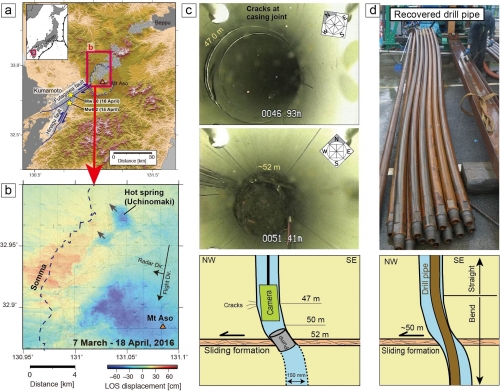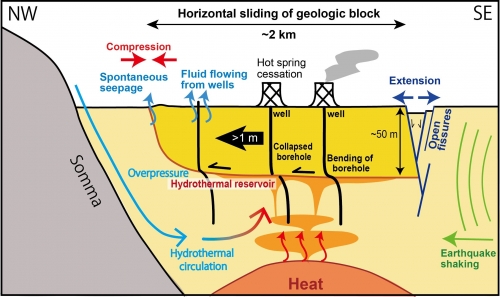研究成果 Research Results
- TOP
- News
- Research Results
- Horizontal sliding of Aso hot spring area during the 2016 Kumamoto earthquake: Mechanism for temporal cessation of hot spring supply
Horizontal sliding of Aso hot spring area during the 2016 Kumamoto earthquake: Mechanism for temporal cessation of hot spring supply
2017.03.15Research ResultsEnvironment & Sustainability
After the 2016 Kumamoto earthquake (Mw 7.0), certain hot springs in the Uchinomaki area became dormant, whereas others experienced increased flow compared with their pre-earthquake state. Here we report the mechanisms underlying the variations of the hot spring supply using satellite data, field observations, descriptions of the temporal variations of the hot springs, and data from a borehole camera. Direct borehole observations demonstrate the sliding along the horizontal geological formation at ~50 m depth , which is where the shallowest hydrothermal reservoir developed. Due to a >1 m northwest movement of the geologic block, as shown by satellite data analyses , extensional open fissures were generated at the southeastern edge of the horizontal sliding block, and compressional deformation and spontaneous fluid emission from wells were observed at the northwestern edge of the block. The temporal and spatial variation of the hot spring supply during the earthquake can be explained by the horizontal sliding of the kilometre-scale hot spring area and borehole failures. Because there was no strain accumulation around the hot spring area prior to the earthquake, and gravitational instability could be ignored, the horizontal sliding was likely caused by liquefaction (i.e., low-friction along the ~50m formation).

(a) The location of hot spring area on the map of central Kyushu Island, Japan. (b) Surface deformation revealed via satellite data analyses. Blue in the Uchinomaki area moved northwest direction (~1.5m). (c) Pictures of the boreholes taken inside the casing pipe show the bending of the borehole at ~50 m in the hot spring area. (d) The drill pipe installed within well for hot spring supply was bent during the 16 April earthquake.

Schematic image of the horizontal sliding of the Aso hot spring area. The earthquake motion caused the kilometre-scale geologic block to slide NW along the horizontal detachment surface at ~50m depth.
Journal Reference
Horizontal sliding of kilometre-scale hot spring area during the 2016 Kumamoto earthquake, ,Scientific Reports, 10.1038/srep42947Research-related inquiries
- TOP
- News
- Research Results
- Horizontal sliding of Aso hot spring area during the 2016 Kumamoto earthquake: Mechanism for temporal cessation of hot spring supply































